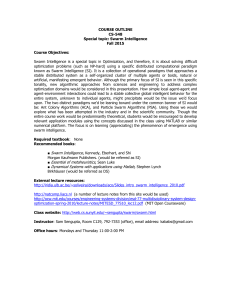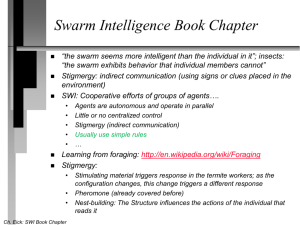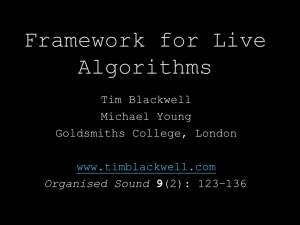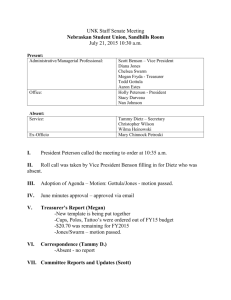Document 10951943
advertisement
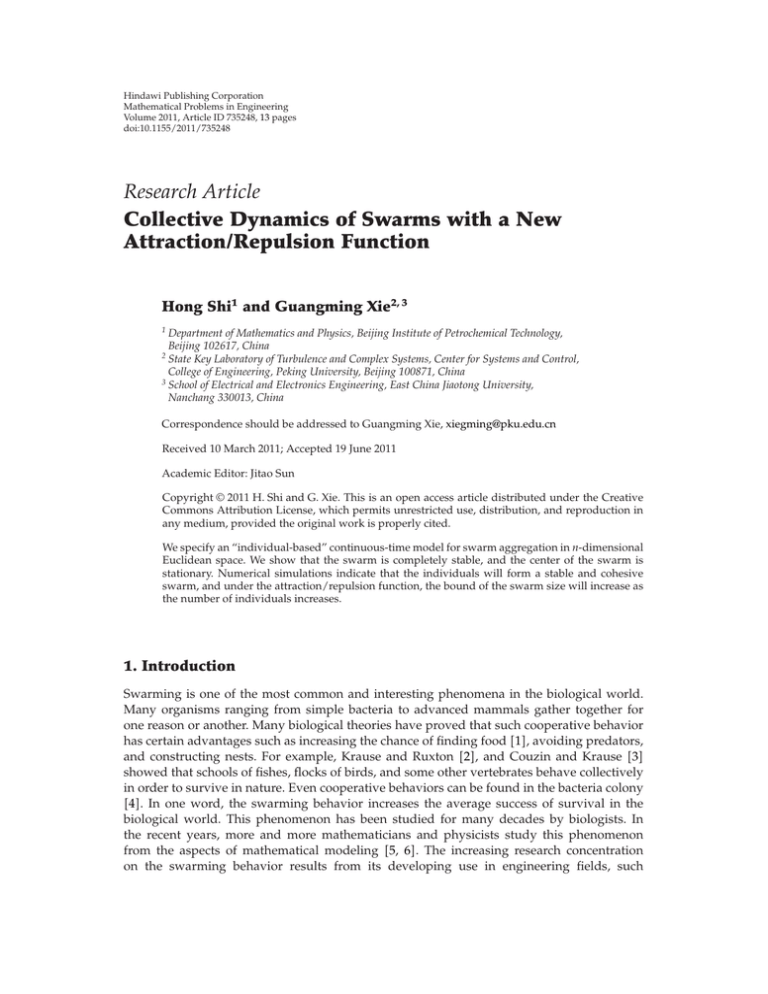
Hindawi Publishing Corporation
Mathematical Problems in Engineering
Volume 2011, Article ID 735248, 13 pages
doi:10.1155/2011/735248
Research Article
Collective Dynamics of Swarms with a New
Attraction/Repulsion Function
Hong Shi1 and Guangming Xie2, 3
1
Department of Mathematics and Physics, Beijing Institute of Petrochemical Technology,
Beijing 102617, China
2
State Key Laboratory of Turbulence and Complex Systems, Center for Systems and Control,
College of Engineering, Peking University, Beijing 100871, China
3
School of Electrical and Electronics Engineering, East China Jiaotong University,
Nanchang 330013, China
Correspondence should be addressed to Guangming Xie, xiegming@pku.edu.cn
Received 10 March 2011; Accepted 19 June 2011
Academic Editor: Jitao Sun
Copyright q 2011 H. Shi and G. Xie. This is an open access article distributed under the Creative
Commons Attribution License, which permits unrestricted use, distribution, and reproduction in
any medium, provided the original work is properly cited.
We specify an “individual-based” continuous-time model for swarm aggregation in n-dimensional
Euclidean space. We show that the swarm is completely stable, and the center of the swarm is
stationary. Numerical simulations indicate that the individuals will form a stable and cohesive
swarm, and under the attraction/repulsion function, the bound of the swarm size will increase as
the number of individuals increases.
1. Introduction
Swarming is one of the most common and interesting phenomena in the biological world.
Many organisms ranging from simple bacteria to advanced mammals gather together for
one reason or another. Many biological theories have proved that such cooperative behavior
has certain advantages such as increasing the chance of finding food 1, avoiding predators,
and constructing nests. For example, Krause and Ruxton 2, and Couzin and Krause 3
showed that schools of fishes, flocks of birds, and some other vertebrates behave collectively
in order to survive in nature. Even cooperative behaviors can be found in the bacteria colony
4. In one word, the swarming behavior increases the average success of survival in the
biological world. This phenomenon has been studied for many decades by biologists. In
the recent years, more and more mathematicians and physicists study this phenomenon
from the aspects of mathematical modeling 5, 6. The increasing research concentration
on the swarming behavior results from its developing use in engineering fields, such
2
Mathematical Problems in Engineering
as coordination, distributed cooperative control, and learning strategies for autonomous
multiagent systems such as autonomous multirobot applications and unmanned undersea,
land, or air vehicles.
Many aspects can be concerned for modeling swarm behaviors 7–24, such as the
mechanism of information transfer between groups and the synergetic process when preying
food as a whole. How information is transmitted within a swarm; how an individual in
a swarm can locate itself and find its right place to stay; and whether individuals in a
swarm can combine together as a whole and keep it stable. Our work is mainly based on
the note 9, in which the author developed a simple model for swarm aggregations based
on interindividual attraction/repulsion interactions and showed that the swarm would get
cohesive in finite time with a constant bound size, regardless of the number of individuals
in the swarm. In 9, the authors technically specified an attraction/repulsion function
which ensures each individual not to move away from the whole swarm. Furthermore, they
amended their model in 10, introduced the environment factor, and showed that the swarm
would avoid unfavorable one.
In this paper, we introduce an adjusted attraction/repulsion function. The function in
this paper works better in modeling the behaviors of swarm because it is more similar to the
swarm in nature. The function indicates that the repulsion increases to infinite as the distance
between two individuals in the swarm decreases to zero, and the attraction decreases to zero
as the distance increases to infinite. However, for the attraction/repulsion function in 9, the
attraction increases to infinite as the distance between two individuals in the swarm increases
to infinite, and the repulsion is bounded as the distance decreases to zero. Furthermore,
numerical simulations show that the bound of the size of the ultimately stable swarm will
increase as the number of individuals in the swarm increases, whereas the increasing rate
will decrease.
2. Model of a Swarm with New Attraction/Repulsion Function
We consider a swarm of N individuals members in an n-dimensional Euclidean space.
We model the individuals as points and ignore their dimensions and assume that they can
change their directions arbitrarily if necessary with no time delays. We assume synchronous
motion and no time delays, that is, all the members move simultaneously and know the exact
positions of all the other members in the swarm, and thus there are no isolated clusters in the
swarm. The equation of motion of individual i is given by
ẋi N
f xi − xj ,
i 1, . . . , N,
2.1
j1,j /
i
where xi ∈ Rn represents the position of individual i; f· represents the function of attraction
and repulsion between the individuals in the swarm. In other words, the direction and
magnitude of motion of each member is determined as a sum of the attraction and repulsion
of all the other members on this member. The attraction/repulsion function that we consider
is
f y −y
b
a
2 − 4
y
y
,
y ∈ Rn ,
2.2
Mathematical Problems in Engineering
3
600
Attraction/repulsion
400
200
0
−200
−400
0
0.2
0.4
0.6
0.8
1
Distance
Figure 1: The attraction/repulsion function.
where a and b are positive constants and y is the Euclidean norm given by y yT y,
which is used to represent the distance between two individuals in the swarm.
For the y ∈ R1 case with a 100 and b 1, this function is shown in Figure 1.
From Figure 1, it is easy to see that as the distance becomes larger, the interaction between
two individuals changes from repulsion interaction force > 0 to attraction interaction
force < 0, and the attraction decreases as the distance gets much larger. The asterisk in
Figure 1 represents the position where the attraction and the repulsion balance. In higher
dimensions i.e, y ∈ Rn , the function is exactly the same as in the one-dimensional case,
except that it acts on the line connecting the positions of the two individuals i.e., the line on
which the vector y lies.
Note that the function f· constitutes an artificial social potential function, similar
to the one in 9, that governs the interindividual interactions. The term a/y2 represents
the attraction, whereas the term b/y4 represents the repulsion. Note that this function is
attractive i.e., a/y2 dominates for large distances and repulsive i.e., b/y4 dominates
for small distances, which is consistent with interindividual attraction/repulsion in biological
swarms. Therefore, it constitutes a crude approximation of biological interactions. The main
difference between the functions in 9 and in this paper is that the repulsion in our model is
unbounded for infinitesimally small arguments; hence, avoidance of collisions between the
individuals can be ensured; on the other hand, the attraction approaches zero as any two
individuals are far away from each other, which can imitate the real swarm in nature more
accurately.
The physical significance of our model is clear. If an individual is close to the others
in the swarm, the repulsion dominates, which ensures the individual far away from them
enough to be “safe”. The repulsion increases as any two individuals get closer because in the
real nature the individuals are inclined to be more apart away from others if they are nearer.
And if an individual is far away from others in the swarm, the attraction dominates, which
makes the individual get closer to the other members of the swarm. However, as the distance
between the individual and the others gets bigger, this individual will loss more connection
to other members of the swarm, and thus, the attraction decreases to zero as the distance
increases to infinity. By equating fy 0, one can find that f· switches sign at the set of
4
Mathematical Problems in Engineering
90
80
70
60
Y
50
40
30
20
0
10
20
30
40
50
60
70
80
X
Figure 2: N 10, radius 11.3242.
100
80
60
Y
40
20
0
0
20
40
60
80
100
X
Figure 3: N 20, radius 13.8718.
points defined as Y {y 0 or y δ b/a}. The distance δ is the distance at which
the attraction and the repulsion balance. Hence, if y < δ, then the repulsion dominates;
˙
if y > δ, then the attraction dominates. Also by equating fy
0, we can find that the
distance y ζ 3b/a is the distance at which the total force of attraction and repulsion
begins to decrease. This is because that with the increase of distance, the individual has less
connection with other members.
3. Stability Analysis
In this section, we analyze the stability of the system and the final motion behaviors of the
swarm members.
Mathematical Problems in Engineering
5
100
80
60
Y
40
20
0
0
20
40
60
80
100
X
Figure 4: N 40, radius 15.9004.
100
80
60
Y
40
20
0
0
20
40
60
80
100
X
Figure 5: N 60, radius 17.0955.
Definition 3.1. The center of the swarm members is defined as
x
N
1
xi .
N i1
3.1
We first prove that because of the symmetry of the attraction/repulsion function f·,
the center x is stationary for all t, which means that the position of the center is decided by the
initial positions of the swarm members. In other words, since f· is symmetric with respect
to the origin, member i moves toward every other member j exactly the same amount as j
moves toward i 9. Hence, we have the following theorem.
Theorem 3.2. The center x of the swarm described in 2.1 with an attraction/repulsion function f·
given in 2.2 is stationary for all t while the whole swarm moves.
6
Mathematical Problems in Engineering
100
80
60
Y
40
20
0
0
20
40
60
80
100
X
Figure 6: N 80, radius 18.0068.
100
80
60
Y
40
20
0
0
20
40
60
80
100
X
Figure 7: N 100, radius 18.7945.
Proof. One can easily see that the function f· is symmetric, that is, f−y −fy for all
y ∈ Rn . Let f1 xi − xj a/xi − xj 2 − b/xi − xj 4 . Thus
ẋ N N
N 1
1
xi − xj f1 xi − xj 0.
ẋi −
N i1
N i1 j1,j / i
3.2
Therefore, the swarm center x is stationary for all t.
This theorem shows that the swarm described by the model in 2.1 and 2.2 is not
drifting. It means that while the swarm members adjust their relative positions to the others,
the whole swarm will not move to another new position.
Mathematical Problems in Engineering
7
100
80
60
Y
40
20
0
0
20
40
60
80
100
X
Figure 8: N 120, radius 19.3436.
100
80
60
Y
40
20
0
0
20
40
60
80
100
X
Figure 9: N 140, radius 20.2340.
In the following, we will further investigate the issue whether the swarm members
will finally stop their motion or will start an oscillatory motion within certain region. Define
the state x of the system as the vector of the positions of the swarm members, that is, x x1T , . . . , xNT T . Let the invariant set of equilibrium points be
Ωe {x : ẋ 0}.
3.3
We will prove that as t → ∞, the state xt converges to Ωe . Namely, the swarm will converge
to its equilibrium points. Therefore, the configuration of the swarm members converges to a
constant arrangement specified by the set of equilibrium points of the system described in
2.1 and 2.2. We first present the following definition 12.
8
Mathematical Problems in Engineering
100
80
60
Y
40
20
0
0
20
40
60
80
100
X
Figure 10: N 160, radius 20.3709.
100
80
60
Y
40
20
0
0
20
40
60
80
100
X
Figure 11: N 180, radius 20.7786.
Definition 3.3. The swarm described in 2.1 is completely stable if every solution converges to
the set of equilibrium point of the system.
Theorem 3.4. Consider the swarm described by the model in 2.1 with an attraction/repulsion
function f· as given in 2.2. The swarm is completely stable, that is, as t → ∞, we have
xt → Ωe .
Proof. Choose the following Lyapunov function:
N
2
1 N−1
b
i
j
a ln x − x Jx ,
2 i1 ji1
xi − xj 2
3.4
Mathematical Problems in Engineering
9
22
20
Radius
18
16
14
12
10
0
50
100
150
200
The number of members
Figure 12: The relation between the number of individuals and the radius of the swarm.
which is an artificial potential function. Computing the gradient of Jx with respect to xi
yields
∇xi Jx N i
x −x
j
j1,j /
i
a
b
−
xi − xj 2 xi − xj 4
−ẋi .
3.5
Then, taking the time derivative of the Lyapunov function Jx along the motion of the
system, we obtain
˙
Jx
∇x JxT ẋ N
i1
N i1
−ẋi
T
∇xi JxT ẋi
N 2
ẋi − ẋi ≤ 0,
3.6
i1
for all t. Thus, using LaSalle’s invariance principle, we can conclude that as t → ∞, the state
xt converges to the largest invariant subset of the set defined by
˙
Ω x : Jx
0 {x : ẋ 0} Ωe .
3.7
Since each point in Ωe is an equilibrium, Ωe is an invariant set, and this proves the expected
result.
The proof of the aforementioned theorem shows the distributed aspect of the
swarming behavior. In fact, it shows that the swarm members are performing distributed
optimization function minimization of a common function the Lyapunov or cost function
using a distributed gradient method. In other words, each member computes its part of the
gradient of the global function at its position i.e., computes the gradient with respect to
10
Mathematical Problems in Engineering
its motion variables and moves along the negative direction of that gradient. The global
function in this case is a function of the distances between the members 9.
Note that the complete stability implies global convergence of the swarm system to
its equilibrium point set, that is, the configuration of the swarm members converges to a
constant arrangement. However, the exact location and the size of this set cannot be known,
in general, especially for large number N of the swarm members, because the equations for
equilibrium points are nonlinear. On the other hand; however, it is naturally expected that
the swarm members will aggregate and form a cluster around the center x. Hence, in the next
section, we will discuss the cohesion of the swarm.
Remark 3.5. Note that in any of the above analyses, we did not use the dimension of the state
space n. Hence, the results obtained hold for any dimension n.
Remark 3.6. The results here are global. This is a consequence of the definition of the
attraction/repulsion function f· in 2.2 over the entire domain.
4. Analysis of Swarm Cohesion
We define a swarm member called a free agent, as in 9, which means that there is no
neighbors in its repulsion range.
Definition 4.1. A swarm member i is called a free agent at time t if
xi t − xj t > δ,
∀j ∈ I, j / i,
4.1
where I {1, . . . , N} is the set of members of the swarm.
Note that if the distance between a free agent and other members in the swarm is
larger than δ, then there will not be repulsion force on the free agent, and the total force on
it will be a combined effect of all the attraction imposed by all the other members. Then we
hope that this total force is pointing toward the center x of the swarm and that the free agent
is moving toward it. To begin the proof of the following theorem, we define the error vector ei
as ei xi − x for all i ∈ I.
Theorem 4.2. Assume that all the members are the free agents in the swarm described by the model
in 2.1 with an attraction/repulsion function f· as given in 2.2 at time t. Then, at time t, their
i 2
motions are in the direction of decrease of N
i1 e (i.e., toward the center x).
Proof. Note that the motion of member i can be represented as
i
ẋ −
N i
x −x
j1,j /
i
j
a
b
−
xi − xj 2 xi − xj 4
,
4.2
and because of Theorem 3.2, we can get
ėi ẋi − ẋ ẋi .
4.3
Mathematical Problems in Engineering
11
iT i
Choose the Lyapunov function for the swarm as V N
i1 Vi , where Vi 1/2e e
represents half of the distance between member i and the swarm center x. Then taking the
derivative of V and by using 4.2 and 4.3, we can obtain
V̇ N
eiT ėi N
i1
⎡
eiT ⎣−
i1
−
N xi − xj
j1,j /i
⎤
−
⎦
xi − xj 2 xi − xj 4
a
eiT ei − ej f1 xi − xj
N
N i1 j1,j /
i
−
N
N−1
b
2 i
e − ej f1 xi − xj
4.4
i1 ji1
−
N
N−1
i1 ji1
b
a− xi − xj 2
,
where f1 xi −xj a/xi −xj 2 −b/xi −xj 4 . Since all the members are the free agents at time t,
i, we can get a−b/xi −xj 2 > 0, for all i, j ∈ I, j /
i.
then xi −xj > δ b/a for all i, j ∈ I, j /
Therefore, we have
V̇ < 0,
4.5
which completes the proof.
Remark 4.3. This theorem is important because it shows the possibility of convergence of the
swarm if the original swarm is dispersive. When the members in the swarm are all free agents,
the members will aggregate around x.
As discussed above, all the members of the swarm will converge to the center x and
form a cluster around x. However, note that the attraction/repulsion function f· in this
i; hence, the agents
paper has infinite repulsion force as xi − xj → 0, for all i, j ∈ I, j /
cannot close unlimitedly.
Definition 4.4. The radius r of the hyper-ball in which the members finally converge is called
a converging radius, and
r max xi − x .
∀i∈I
4.6
We guess that the radius of the hyper-ball in which the members finally converge
will increase as the number of members in the swarm increases. In the next section, we will
perform some numerical simulations to illustrate the guess. And the simulation results will
show that the converging radius increases as the number of members in the swarm increases,
and we will provide an approximate function graph to depict the relationship between the
radius and the number of the members.
12
Mathematical Problems in Engineering
5. Numerical Simulations of the Swarm with the New
Attraction/Repulsion Function
We performed some simulations to illustrate whether our hypothesis is consistent with the
simulation results. Figures 2, 3, 4, 5, 6, 7, 8, 9, 10, and 11 show the states of swarm for the
different numbers of individuals in the swarm, where the circles represent the initial positions
of members and the asterisks represent the positions of the swarm center. We chose the
swarm sizes from 10 to 180. From these figures, it is easy to see that the radius of swarm
increases gradually as the number of individuals in the swarm increases, and the increasing
rate decreases as the number of individuals in the swarm increases. Figure 12 presents the
relation between the number of individuals in the swarm and the converging radius of the
swarm, the increasing trend also clearly indicates that the new attraction/repulsion function
works well. All the simulation results strongly support the hypothesis before.
6. Concluding Remarks
In this paper, we developed a model of swarm with a new attraction/repulsion function.
We analyzed the stability of the swarm system and the aggregation characteristic of the
swarm and illustrated by numerical simulations that the radius of the swarm will increase
as the number of individuals in the swarm increases. The simulation results presented the
approximate relationship between the number of individuals and the swarm radius. This
model can be used in studying how individuals forage and chase food in groups. And
furthermore, this model can be extended to other more complicated cases in a group that
are considered in 10–15. The following two questions can be further studied: the precise
analytic relationship between the number of individuals in a swarm and the radius of the
swarm; the motion behaviors within multiple swarms using the attraction/repulsion function
provided in this paper.
References
1 D. W. Stephens and J. R. Krebs, Foraging Theory, Princeton University Press, Princeton, NJ, USA, 1986.
2 J. Krause and G. Ruxton, Living in Groups, Oxford University Press, Oxford, UK, 2002.
3 I. D. Couzin and J. Krause, “Self-organization and collective behavior in vertebrates,” Advances in the
Study of Behavior, vol. 32, pp. 1–75, 2003.
4 K. M. Passino, “Biomimicry of bacterial foraging for distributed optimization and control,” IEEE
Control Systems Magazine, vol. 22, no. 3, pp. 52–67, 2002.
5 E. Boabeau, M. Dorigo, and G. Theraulaz, Swarm Intelligence: From Natural to Artificial Systems, Oxford
University Press, Oxford, UK, 1999.
6 A. Czirók and T. Vicsek, “Collective behavior of interacting self-propelled particles,” Physica A:
Statistical Mechanics and its Applications, vol. 281, no. 1, pp. 17–29, 2000.
7 I. D. Couzin, J. Krause, N. R. Franks, and S. A. Levin, “Effective leadership and decision-making in
animal groups on the move,” Nature, vol. 433, no. 7025, pp. 513–516, 2005.
8 G. Grégoire, H. Chaté, and Y. Tu, “Moving and staying together without a leader,” Physica D. Nonlinear
Phenomena, vol. 181, no. 3-4, pp. 157–170, 2003.
9 V. Gazi and K. M. Passino, “Stability analysis of swarms,” IEEE Transactions on Automatic Control, vol.
48, no. 4, pp. 692–697, 2003.
10 V. Gazi and K. M. Passino, “Stability analysis of social foraging swarms,” IEEE Transactions on Systems,
Man, and Cybernetics, Part B: Cybernetics, vol. 34, no. 1, pp. 539–557, 2004.
11 V. Gazi and K. M. Passino, “A class of attractions/repulsion functions for stable swarm aggregations,”
International Journal of Control, vol. 77, no. 18, pp. 1567–1579, 2004.
Mathematical Problems in Engineering
13
12 T. Chu, L. Wang, T. Chen, and S. Mu, “Complex emergent dynamics of anisotropic swarms:
convergence vs oscillation,” Chaos, Solitons and Fractals, vol. 30, no. 4, pp. 875–885, 2006.
13 L. Wang, H. Shi, T. Chu, W. Zhang, and L. Zhang, “Aggregation of foraging swarms,” in Lecture Notes
in Artificial Intelligence, vol. 3339, pp. 766–777, Springer, Berlin, Germany, 2004.
14 H. Shi, L. Wang, T. Chu, and F. Xiao, “Self-organization of general multi-agent systems with complex
interactions,” in Proceedings of the IEEE/RSJ International Conference on Intelligent Robots and Systems
(IROS ’06), pp. 3203–3208, October 2006.
15 H. Shi, L. Wang, T. Chu, and M. Xu, “Collective dynamic behavior of anisotropic foraging swarms,”
in Proceedings of the American Control Conference (ACC ’07), pp. 2563–2568, July 2007.
16 B. Liu, T. G. Chu, L. Wang, and Z. F. Wang, “Swarm dynamics of a group of mobile autonomous
agents,” Chinese Physics Letters, vol. 22, no. 1, pp. 254–257, 2005.
17 H. G. Tanner, A. Jadbabaie, and G. J. Pappas, “Flocking in fixed and switching networks,” IEEE
Transactions on Automatic Control, vol. 52, no. 5, pp. 863–868, 2007.
18 R. Olfati-Saber, “Flocking for multi-agent dynamic systems: algorithms and theory,” IEEE Transactions
on Automatic Control, vol. 51, no. 3, pp. 401–420, 2006.
19 H. Shi, L. Wang, and T. Chu, “Virtual leader approach to coordinated control of multiple mobile
agents with asymmetric interactions,” Physica D. Nonlinear Phenomena, vol. 213, no. 1, pp. 51–65, 2006.
20 Y. Hong, J. Hu, and L. Gao, “Tracking control for multi-agent consensus with an active leader and
variable topology,” Automatica, vol. 42, no. 7, pp. 1177–1182, 2006.
21 H. Shi, L. Wang, and T. Chu, “Flocking of multi-agent systems with a dynamic virtual leader,”
International Journal of Control, vol. 82, no. 1, pp. 43–58, 2009.
22 G. Xie and L. Wang, “Moving formation convergence of a group of mobile robots via decentralised
information feedback,” International Journal of Systems Science, vol. 40, no. 10, pp. 1019–1027, 2009.
23 G. Xie and L. Wang, “Consensus control for a class of networks of dynamic agents,” International
Journal of Robust and Nonlinear Control, vol. 17, no. 10-11, pp. 941–959, 2007.
24 F. Xiao and L. Wang, “Asynchronous consensus in continuous-time multi-agent systems with
switching topology and time-varying delays,” IEEE Transactions on Automatic Control, vol. 53, no. 8,
pp. 1804–1816, 2008.
Advances in
Operations Research
Hindawi Publishing Corporation
http://www.hindawi.com
Volume 2014
Advances in
Decision Sciences
Hindawi Publishing Corporation
http://www.hindawi.com
Volume 2014
Mathematical Problems
in Engineering
Hindawi Publishing Corporation
http://www.hindawi.com
Volume 2014
Journal of
Algebra
Hindawi Publishing Corporation
http://www.hindawi.com
Probability and Statistics
Volume 2014
The Scientific
World Journal
Hindawi Publishing Corporation
http://www.hindawi.com
Hindawi Publishing Corporation
http://www.hindawi.com
Volume 2014
International Journal of
Differential Equations
Hindawi Publishing Corporation
http://www.hindawi.com
Volume 2014
Volume 2014
Submit your manuscripts at
http://www.hindawi.com
International Journal of
Advances in
Combinatorics
Hindawi Publishing Corporation
http://www.hindawi.com
Mathematical Physics
Hindawi Publishing Corporation
http://www.hindawi.com
Volume 2014
Journal of
Complex Analysis
Hindawi Publishing Corporation
http://www.hindawi.com
Volume 2014
International
Journal of
Mathematics and
Mathematical
Sciences
Journal of
Hindawi Publishing Corporation
http://www.hindawi.com
Stochastic Analysis
Abstract and
Applied Analysis
Hindawi Publishing Corporation
http://www.hindawi.com
Hindawi Publishing Corporation
http://www.hindawi.com
International Journal of
Mathematics
Volume 2014
Volume 2014
Discrete Dynamics in
Nature and Society
Volume 2014
Volume 2014
Journal of
Journal of
Discrete Mathematics
Journal of
Volume 2014
Hindawi Publishing Corporation
http://www.hindawi.com
Applied Mathematics
Journal of
Function Spaces
Hindawi Publishing Corporation
http://www.hindawi.com
Volume 2014
Hindawi Publishing Corporation
http://www.hindawi.com
Volume 2014
Hindawi Publishing Corporation
http://www.hindawi.com
Volume 2014
Optimization
Hindawi Publishing Corporation
http://www.hindawi.com
Volume 2014
Hindawi Publishing Corporation
http://www.hindawi.com
Volume 2014




